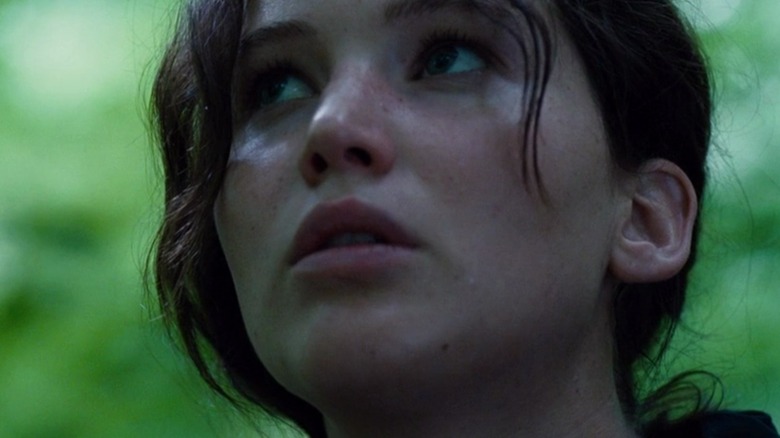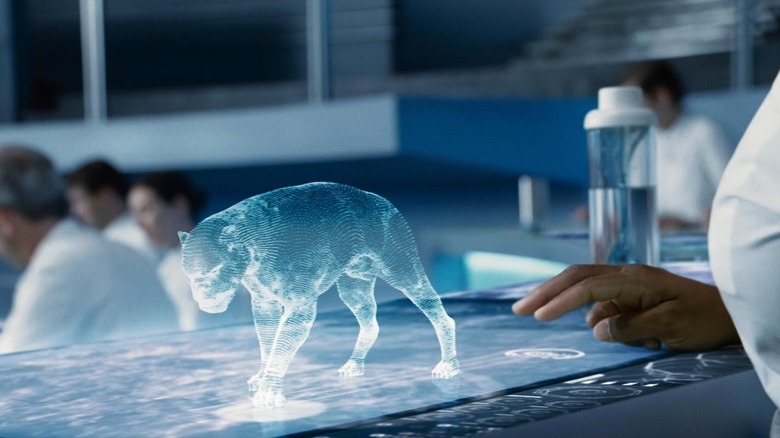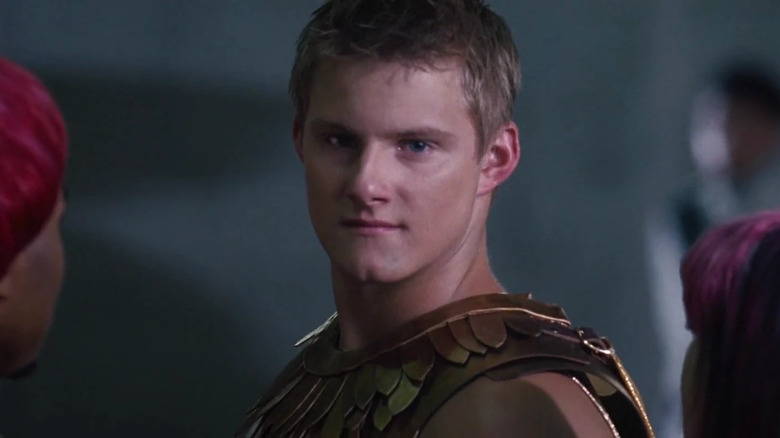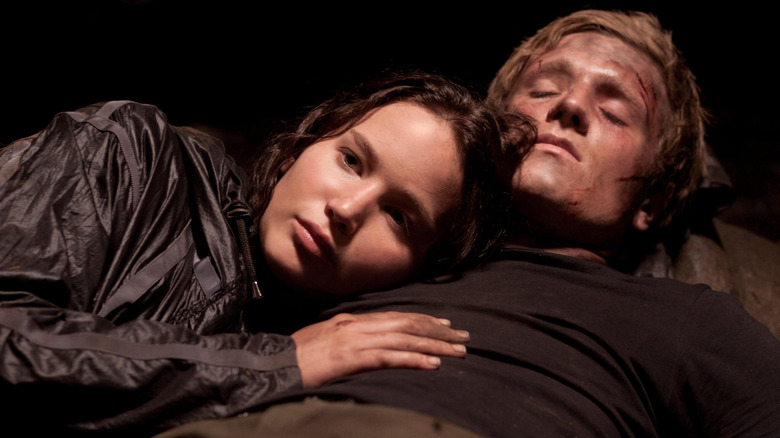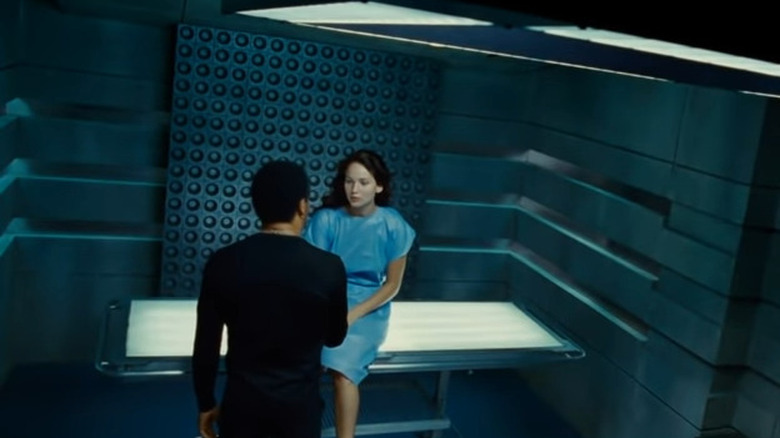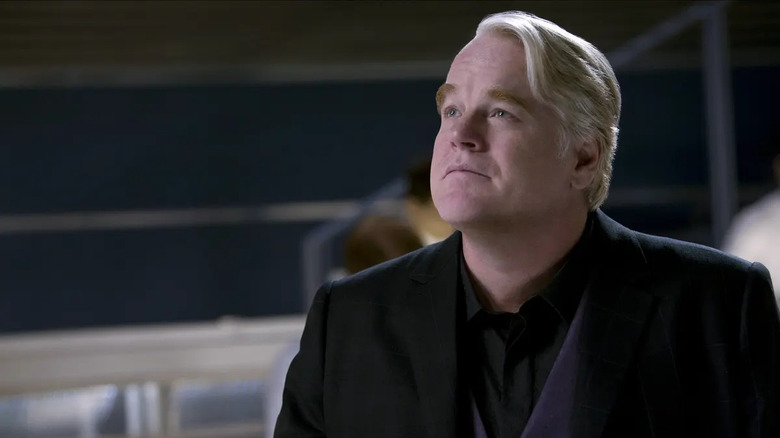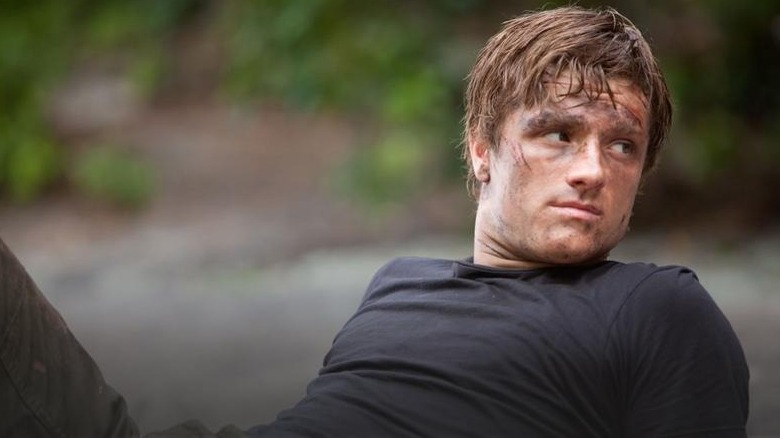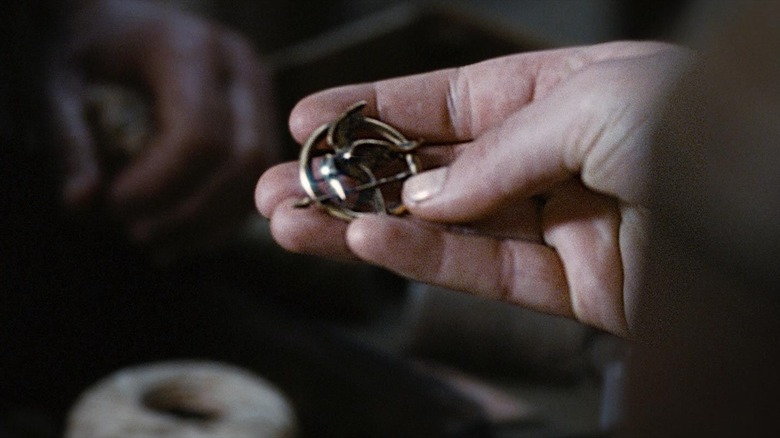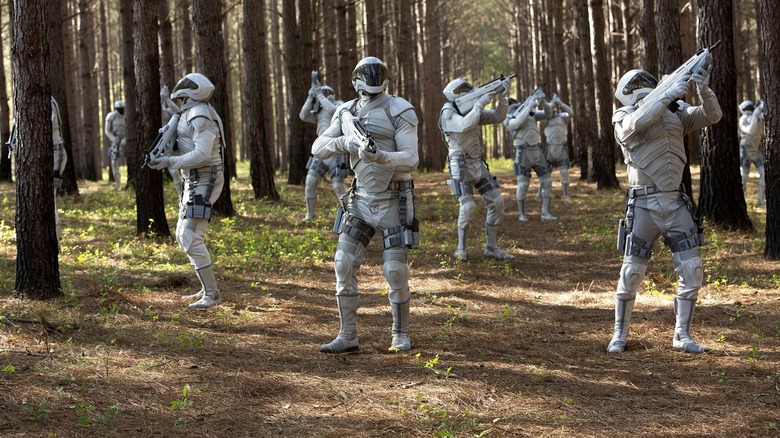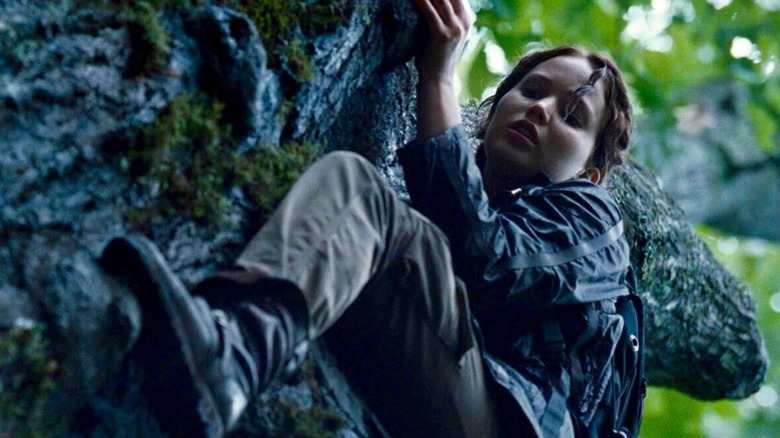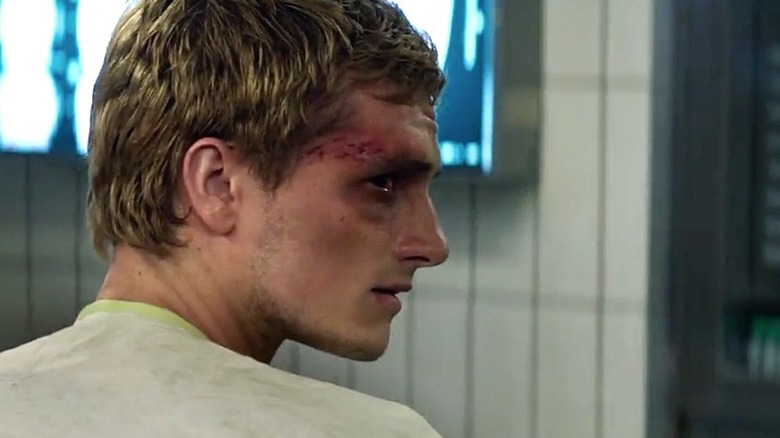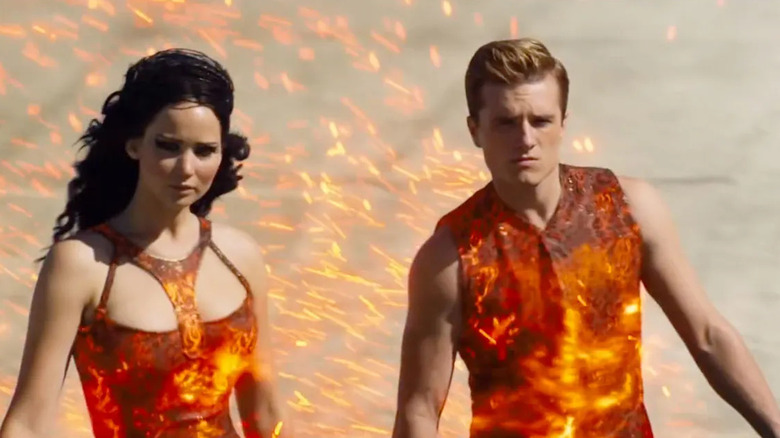Memorable Hunger Games Book Moments That Never Happened In The Movies
A decade ago, the first "Hunger Games" film was released and became one of the biggest young adult (YA) book adaptations to hit the big screen. And since its release, no other YA book adaptation has lived up to the same hype as "The Hunger Games." (We're looking at you "Divergent" film series.) It helped launch Jennifer Lawrence into stardom, and for that, many will always be eternally grateful.
Written by Suzanne Collins, "The Hunger Games" novels provided an in-depth look at the world of Panem, and how, each year, two kids from every District are selected as Tribute to take part in the deadly Hunger Games. And while the films did an adequate job at bringing these pages to life, there were still some integral moments that were completely left out or changed when being adapted to the big screen. Therefore, we're here to out acknowledge the most memorable book moments that never made it in the films. Read on if you want to revisit the games, and may the odds be ever in your favor.
The Avox
In the books, an Avox is described as essentially a slave to the Capitol. They're people who are punished for trying to rebel against the Capitol leader, President Snow, and are seen as traitors. Once caught, they have their tongues cut out and are rendered mute. Avoxes are then forced to work in servant-like roles to serve the people of the Capitol as the lowest class.
The film's decision to practically leave out the story of the Avox is somewhat puzzling, as their stories only further detail how wicked the Capitol and President Snow are. In "The Hunger Games" novel, Katniss and Gale are seen hunting in the woods when they witness a Capitol hovercraft killing a runaway and capturing another one nearby. When Katniss is preparing for the Games in the Capitol, she sees that captured runaway has been turned into an Avox. While the films do touch on the Avoxes with the character Pollux (Elden Henson) in "The Hunger Games: Mockingjay Part 1" and "Part 2," his story is more detailed in the novels — he has a brother who rescues him from being forced to work underground for five years as an Avox. In the book, his story adds an emotional element for Katniss to stop President Snow.
The Portrayal of the Mutations
At the end of "The Hunger Games" film, Katniss, Peeta (Josh Hutcherson), and Cato (Alexander Ludwig) are the last Tributes left alive. The Capitol releases a pack of wolf-like creatures to finish off the last two in order to have one victor left standing. While the mutations (or mutts) were vicious in the film, the book described them as being downright terrifying.
In "The Hunger Games" novel, the mutts were created by the Capitol and described as having razor-sharp claws and the ability to jump incredibly high off their hind legs. However, what made them so terrifying was that the Capitol designed their faces to resemble each one of the fallen Tributes from the Games. They were given collars marked with the District numbers of the Tributes and were even given human-like eyes that made people question if these mutts were truly their fallen Tributes. In the book, Peeta even questions if the Capitol actually used the dead Tributes' eyes when creating the mutts. Of all the hybrid-like creatures mentioned in these books, these mutations truly felt like they were from a nightmare. Perhaps the movie choose to remove this aspect of the mutts in the hopes of not absolutely terrifying its audience, as most fans of the films were typically younger (per Entertainment Weekly) and didn't sign up to watch a horror movie.
Cato's Death
In "The Hunger Games" film, Cato is killed by the Capitol mutations — but not before coming to the realization that he was already dead the moment he volunteered as Tribute. He goes on to say that his whole life has been nothing but a game, and that he was raised to be a pawn for the Capitol to fight and die for their amusement. His realization gives Cato somewhat of a redemption arc, as he sees that he's as much a slave to the Capitol as Katniss and Peeta are. Even though his District is privileged, he realizes that they're all the same.
In the book, Cato never has this moment of clarity. He dies as the same formidable threat to Katniss and Peeta, and is given a graphic death to match with his brutal behavior throughout the book. While Cato's ending in the film is more emotional, his ending in the book carries more weight. Readers see that, even when facing death and all the terrible things the Capitol has thrown at him during the Games, he's still loyal to them, and is ultimately just an extension of their power. It makes the very idea of defeating them seem impossible.
Peeta Claiming Katniss Was Pregnant
This is something that was shown in both the book and film "Catching Fire" — even if the follow up wasn't the same. Now that Katniss and Peets have won the 74th Hunger Games, the Capitol makes plans for the 75th. President Snow (Donald Sutherland) decides to pick Tributes from the existing winner's pool from each District. Because Katniss is the only woman to have ever won from District 12, it means that she's going back in no matter what.
In an attempt to save Katniss, Peeta lies on camera, telling everyone that she's pregnant with his child in the hopes of gaining sympathy and getting her excluded from the Games. While this does happen in the film, it's seemingly forgotten about after his dramatic announcement. However, in the book, the other Tributes are aware of the ruse but encourage Katniss to play out her condition throughout the Games. Later on, in the third book "Mockingjay," this story is brought up again. Katniss lies and says that she lost the baby, again to gain sympathy to her cause, but to also explain why and how she was not showing.
Katniss's Make-up Team
In the books, Katniss has a make-up team that gets her camera ready. Though they are from the Capitol, Katniss grows a fondness for them, treating them like children who don't know any better rather than adults who are preparing her for slaughter. While the team can briefly be seen in the film "The Hunger Games," they are relatively forgotten for the other three films, with her designer Cinna (Lenny Kravitz) taking on most of the role to get Katniss ready.
In the film "The Hunger Games: Mocking Jay Part 1" Effie Trinket (Elizabeth Banks) is captured by the District 13 rebels and is used to help get Katniss camera ready for her video propaganda against the Capitol. While Banks's performance of the character was excellent, in the book "Mockingjay," it's Katniss's make-up team of Octavia, Flavius, and Venia that are captured to help prep her. The make-up team worked as a way to showcase that not everyone from the Capitol was evil — many were just living obliviously in their bubble. And while Octavia, Flavius, and Venia were practically cut out from the films, Effie's role was able to stand in as someone from the Capitol who wasn't that bad. Nothing was ever black or white in "The Hunger Games."
The Watch of Plutarch Heavensbee
"Catching Fire" introduced readers to Plutarch Heavensbee, the new Gamemaker for the Capitol. And while that would technically make him an antagonist for Katniss, it turns out that he's working with District 13 to take down the Capitol. Unbeknownst to Katniss, Plutarch, Haymitch (Woody Harrelson), and most of the other Tributes were in on a plot to break Katniss out in order to have her be the face of their revolution against President Snow.
In the films, Plutarch is portrayed by the late Philip Seymour Hoffman and is shown to be close to President Snow, making his ultimate betrayal towards particularly surprising. However, in the book, there's one big sign that indicated Plutarch is on Katniss's side: When Katniss is first introduced to Plutarch at a party in the Capitol, he shows her his watch, which has the symbol of her Mockingjay on it. This watch is important for two reasons. First, it indicates that he's a rebel, as the rebellion has used her Mockingjay pin as a sign of resistance. The second reason is the watch itself — the arena for the Games is a clock, with new threats arising every hour in different sections like the face of a clock. While this hint was subtly placed in the book, it may have been a bit too on the nose for viewers in the film.
Peeta Loses His Leg
At the end of "The Hunger Games," Peeta is attacked and bitten by one of the mutts. His leg is damaged but the Capitol doctors are able to heal him after he and Katniss are announced the winners of the Games. Things play out much differently in the books, however. While Peeta does get attacked by the mutts, he almost dies due to blood loss. Katniss does some quick thinking and applies pressure to staunch the blood flow, thus saving Peeta's life.
However, later on, Peeta shares that he had to have his leg amputated from below the knee and was given an artificial leg by the Capitol. The loss of his leg plays a big part in Peeta's story in the "Mockingjay" book. After the events of "Catching Fire," Peeta is captured by the Capitol and toured through the first half of the book. When he's returned, he discusses the mental and physical torture that he endured. On top of the loss of his leg and the destruction of his town District 12, Peeta goes through a lot of trauma that tends to get washed over in the films.
How Katniss Receives Her Mockingjay Pin
Throughout the books and films, Katniss inadvertently becomes the face of the rebellion against the Capitol and President Snow. During the first Games, Katniss adorns a Mockingjay pin that she continues to wear throughout the remainder of the series. The Mockingjay becomes a symbol for the rebellion with Katniss being the face, whether she wanted to be or not.
In the film, Katniss stumbles upon the pin and gives it to her younger sister Prim (Willow Shields) for luck. Prim then returns the pin to Katniss once she's volunteered as Tribute. However, in the book, Katniss is given the pin by her friend Madge Undersee, the daughter of District 12's Mayor. When Katniss volunteers as Tribute in place of her sister Prim, Madge goes to visit Katniss and offers the pin as a Tribute token. Katniss chooses to wear it during the Games as a way to remember why she's fighting to stay alive. Little did she know, her pin would act as a symbol for thousands to remember why they're fighting to stay alive as well.
District 12 Peacekeeper Darius
In the books, Darius is a young Peacekeeper in District 12. While his job is to uphold the law, he has a pretty lax sense of right and wrong, and Katniss would often chat with him while in the Hob market as a friend. Things take a turn for the worse in "Catching Fire," when President Snow decides to remind the people of District 12 that he's in control. With the scent of rebellion rising in other Districts, Snow sends a group of cruel Peacekeepers to District 12 to maintain the Capitol's presence and control on the District's poor residents.
One of the new Peacekeepers, Romulus Thread, decides to make an example out of Katniss's friend Gale by whipping him in front of everyone. When Darius attempts to stop him, Romulus knocks him out. Katniss is horrified to discover that Darius is later turned into an Avox when she sees him in the Capitol as she prepares for the next Hunger Games. In "Mockingjay," Peeta tells Katniss that Darius was tortured to death in the cell next to him. They would interrogate him for information on the rebels, but since he was an Avox he couldn't talk and would just late out wailing sounds. Peeta believes that they never truly wanted information, arguing that they just wanted to cause him pain. His death was incredibly violent and hurt Katniss deeply.
Unfortunately, his character was completely omitted from the films.
Katniss Suffers From Dehydration
While the Games did not look like a good time in "The Hunger Games" film, it was much worse in the book. In the book, Katniss goes through severe dehydration since she can't find a viable source of water. While the Tributes and the Games itself were a huge concern on the potential of Katniss surviving, it was the lack of water that looked to be Katniss's downfall for the majority of her time in the first book.
However, in the film, this point is largely glossed over. Katniss finds a source of water pretty early on and goes about her time in the Games business as usual. This may have been a creative decision, as audiences might not have enjoyed watching a film about Katniss trying to find water and slowly dying from dehydration. So, in the interest of time, the entire plot was, for the most part, cut out. While the reasoning makes sense, it does make the idea of surviving the Games seem even less realistic.
Peeta Getting Attacked on Camera
Peeta has a rough time throughout the series, whether you look at the books or the films.
Once Peeta was captured by the Capitol following the events of "Catching Fire," he is held and tortured by President Snow alongside fellow Tribute and rebel Johanna Mason (Jena Malone). In the movie "The Hunger Games: Mockingjay Part 1," Peeta is forced to make Capitol propaganda films, condemning the acts of Katniss and the other rebels. While people believe Peeta to be a traitor, Katniss can see in his face the torment that he's going through behind the scenes.
In the movie, Peeta is able to warn District 13 that the Capitol is coming to attack when the feed is abruptly cut off. However, in the book "Mockingjay," this is far worse — they cut the feed after showing Peeta getting beat on camera. This infuriates Katniss, and gives her a glimpse into her true feelings for Peeta.
Katniss Literally Catches Fire
Throughout the story, Katniss was known as the girl on fire thanks to her stylist, Cinna. During her interviews for the first Games, he created a dress for her that literally caught fire. This idea stuck with her into the second Games, as she and Peeta were displayed in matching outfits designed to catch fire once more. During her time with District 13 and the rebellion, Katniss made a powerful speech, telling President Snow and the people in the Capitol, "If we burn, you burn with us." Fire seems to follow Katniss everywhere she goes.
However, what the films left out was that Katniss literally catches fire by the story's end, and her entire body gets covered in burns. While it's darkly poetic that the girl on fire actually catches fire, the film provided an incredibly watered-down version of her burns. In the book, the burns are still present at the end of the story, with Katniss applying ointment to help. However, in the movie, the burns are all but gone. This was possibly to keep the "Hunger Games" star Jennifer Lawrence recognizable throughout the entire movie, but it did take away from the idea that if you play with fire, you'll eventually get burned. But as Katniss says, there are worse games to play.
